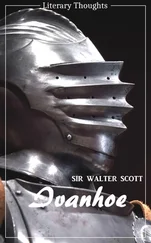Walter Scott - Ivanhoe
Здесь есть возможность читать онлайн «Walter Scott - Ivanhoe» — ознакомительный отрывок электронной книги совершенно бесплатно, а после прочтения отрывка купить полную версию. В некоторых случаях можно слушать аудио, скачать через торрент в формате fb2 и присутствует краткое содержание. Жанр: Исторические приключения, на английском языке. Описание произведения, (предисловие) а так же отзывы посетителей доступны на портале библиотеки ЛибКат.
- Название:Ivanhoe
- Автор:
- Жанр:
- Год:неизвестен
- ISBN:нет данных
- Рейтинг книги:4 / 5. Голосов: 1
-
Избранное:Добавить в избранное
- Отзывы:
-
Ваша оценка:
- 80
- 1
- 2
- 3
- 4
- 5
Ivanhoe: краткое содержание, описание и аннотация
Предлагаем к чтению аннотацию, описание, краткое содержание или предисловие (зависит от того, что написал сам автор книги «Ivanhoe»). Если вы не нашли необходимую информацию о книге — напишите в комментариях, мы постараемся отыскать её.
Ivanhoe — читать онлайн ознакомительный отрывок
Ниже представлен текст книги, разбитый по страницам. Система сохранения места последней прочитанной страницы, позволяет с удобством читать онлайн бесплатно книгу «Ivanhoe», без необходимости каждый раз заново искать на чём Вы остановились. Поставьте закладку, и сможете в любой момент перейти на страницу, на которой закончили чтение.
Интервал:
Закладка:
Introduction

From the beginning, Ivanhoe was distinguished by its huge readership and cult appeal. It sold 10,000 copies in its first two weeks, an unheard-of rate in 1819. That same year, a stage version opened in New York, and later Rossini composed Ivanhoe, the opera. Walter Scott had begun his literary career two decades earlier as a collector of Scottish ballads. He then turned his hand to poetry, specializing in grand romantic vistas and heroic themes from Scottish history. “The Lady of the Lake” (1810) made his name and fortune (which he later lost). But then along came Lord Byron. Almost overnight, Childe Harold’s Pilgrimage made Scott’s narrative poetry seem provincial and old hat. Making a virtue of necessity, Scott turned to fiction, with spectacular results. Waverley (1814), which looked back to Bonnie Prince Charlie’s Scots rebellion of 1745, was something altogether new to the British reader: the recreation of an entire historical canvas, populated by romantic but credible characters, acting out Britain’s painful emergence from its tribal past into modernity and nationhood. Variations on these themes inspired a further sequence of highly successful “Scottish” novels until in 1819, the ever-restless Scott felt the Caledonian well had run dry, and he ventured a new tale removed in both time and place: the England of the Middle Ages. The result was a book that can lay claim to being the most widely read novel of the nineteenth century, and among the most popular of all time.
Ivanhoe maintains a strong readership today, when the rest of Scott’s extraordinary literary output has sunk into obscurity, but it has never been a great critical success. The Scott purists wish he had never traveled south to England at all, and his compatriot David Daiches typifies the twentieth-century scholarly opinion of the novel: “Ivanhoe, though it has qualities of its own, is much more superficial than any of the Scottish novels, and is written throughout on a much lower plane. Scott did not, in fact, know the Middle Ages well and he had little understanding of its social or religious life” (“Scott’s Achievement as a Novelist,” p. 46; see “For Further Reading”). Since the 1980s, critics have turned back to Ivanhoe as an important thesis on British nationalism, and for its racial and sexual themes, but whatever the vicissitudes of its reputation among literary scholars, the novel always has enjoyed a cultural afterlife that much exceeded its scope and pretensions as literature. Ivanhoe single-handedly revived the age of chivalry in the Western popular imagination, and produced a cult of medieval rites and manners that persists into our own age, with its “Dungeons and Dragons” and Lord of the Rings. As for its cultural politics, the impact of Ivanhoe has been felt most deeply and controversially not in Britain, but in the United States.
“I lie here dying, slowly dying, under the blight of Sir Walter,” wrote Mark Twain to a friend in 1903 (Letters, p. 738). Scott loomed large for Twain the writer, who lamented the impact of his “wordy, windy, flowery ‘eloquence’” on American literature. But far more serious for Twain was the enduring cultural impression made by Scott’s Ivanhoe on the American South. The antebellum South was an essentially feudal system of rank and caste, and its white ruling class found in Scott’s romantic tale of chivalrous knights, powerful land-owning barons, and loyal serfs a glorious mirror image of itself. For Twain, whatever impetus toward modernization had existed toward “liberty, humanity, and progress” in the South was effectively smothered by the popularity of Scott, whose novels “set the world in love with dreams and phantoms; with decayed and swinish forms of religion; with decayed and degraded systems of government; with the sillinesses and emptinesses, sham grandeurs, sham gauds, and sham chivalries of a brainless and worthless long-vanished society.” The Scott “disease,” he went so far as to say, had caused the Civil War (Mississippi Writings, pp. 500-501). Ivanhoe became, arguably, even more necessary to the South after that war was lost. Scott’s title character spends much of the novel in disguise, and achieves his greatest triumph in the character of “The Disinherited Knight.” He is named for his estate—he is Wilfred of Ivanhoe—but does not or cannot claim it. Ivanhoe the place is never visited and barely mentioned, as if forgotten. The novel’s title thus points to a glaring absence in the world of the novel, both spiritual and material. England has been conquered, and the spoils have gone to the victorious Normans. As his chivalric pseudonym suggests, Ivanhoe the man is a complex figure representing both inherited nobility and loss, a romantic composite uniquely designed to appeal to the defeated Confederate sensibility.
If Ivanhoe’s fall from land-owning scion to homeless errant knight elicited a fragrant bitterness for the southern reader, no less intoxicating was the situation of his heart, torn between the blond, blue-eyed Saxon princess, Rowena, and the exotic Jew, Rebecca. It is one of literature’s most intriguing love triangles. Much controversy surrounds Scott’s representation of Jews in Ivanhoe, but one suggestive means of understanding the intense and destabilizing desires Rebecca inspires is as a figure for the white man’s attraction for and resistance to the prospect of racial mixture. This is certainly how the late-nineteenth-century African-American novelist Charles Chesnutt interpreted Ivanhoe’s dilemma. For Chesnutt, Scott was “the literary idol of the South,” and Chesnutt’s novel, The House Behind the Cedars (1900), contains a fascinating revision of one of Ivanhoe’s central episodes, the tournament at Ashby where the victorious Ivanhoe awards the crown to the fair Rowena. In Chesnutt’s novel, the Queen of Love and Beauty is also named Rowena, but she is dark: In fact, she is a mulatta passing for white. As another character later remarks, “She should have been named Rebecca instead of Rowena” (p. 92). In Chesnutt’s novel, Rowena’s rival is not a person, but a racial “other” incorporated within the romantic heroine herself. Ivanhoe’s romantic triangle is dissolved into an image of racial ambiguity, a mirror of his own ambivalence. Unsurprisingly, Chesnutt’s “black” Rowena dies in tragic circumstances. In Scott’s novel, the hero begins as a figure for cultural crossing—he has left his Saxon household to follow the Norman king—but the question of whether he is capable of making a second crossing, this time into an ostracized racial group, hangs over the novel until the very end. On the last page, describing Ivanhoe’s marriage to Rowena, Scott refuses to inquire “whether the recollection of Rebecca’s beauty and magnanimity did not recur to his mind more frequently than the fair descendant of Alfred might altogether have approved.” If Scott is reluctant, generations of readers have not been so coy. It is a cliché of Ivanhoe’s reception that the reader will inevitably wish the hero to have chosen the dark and inspiring Rebecca over her bland, blond rival.
As Chesnutt’s revisionary novel makes clear, Ivanhoe, fairly or not, has been put to use as a racist text. The American historical novelist Thomas Dixon based his reconstruction trilogy on a white supremacist reading of Ivanhoe —beginningwith A Leopard’s Spots (1902). Likewise, the Ku Klux Klan’s very name echoes the romantic “clans” of Scott’s fiction. The concluding chapters of Ivanhoe, which focus on the rituals of the Templar Knights, are especially haunting for the American reader. A secretive order of Christian militant men, dressed in white, take a dark-complexioned woman as prisoner, then conduct an extra-legal show trial at which she is condemned to burn at the stake. Rebecca is, of course, a Jew, and is saved at the last, so Scott could not have known in writing Ivanhoe that he was producing the iconography—the hooded white garb, the Masonic rituals, the burning cross—for the vilest and most feared racist organization in modern America.
Читать дальшеИнтервал:
Закладка:
Похожие книги на «Ivanhoe»
Представляем Вашему вниманию похожие книги на «Ivanhoe» списком для выбора. Мы отобрали схожую по названию и смыслу литературу в надежде предоставить читателям больше вариантов отыскать новые, интересные, ещё непрочитанные произведения.
Обсуждение, отзывы о книге «Ivanhoe» и просто собственные мнения читателей. Оставьте ваши комментарии, напишите, что Вы думаете о произведении, его смысле или главных героях. Укажите что конкретно понравилось, а что нет, и почему Вы так считаете.








